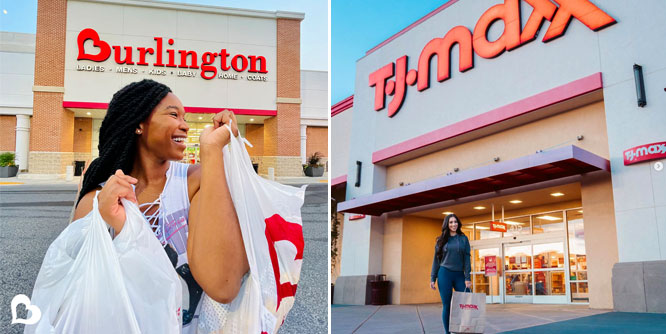
Sources: Facebook/@BurlingtonStores; Instagram/@tjmaxx
June 3, 2022
Are off-pricers holding a glass that is half-full or half-empty?
TJX, Ross Stores and Burlington Stores all reported sales shortfalls in the first quarter, but they remain confident they will eventually benefit from consumers trading down in a potentially tougher and more promotional marketplace.
Burlington blamed its first-quarter sales miss on late deliveries and gave cautious second-quarter guidance due in part to inflation’s impact on lower income customers. Michael O’Sullivan, CEO, also said many retailers are “overinventoried and overbought” and that may drive a “very promotional environment” later in the second quarter. He said, “This kind of environment tends to hurt our business.”
On the positive side, he said the buying environment is “better than it has been for years” and inflation and a possible broader economic slowdown should lead to consumers trading down for value. Mr. Sullivan added, “Clearly, there is a lot of focus and concern about the lower income customer right now.”
Ross Stores cut its annual guidance due to a below-plan quarter and macroeconomic pressures.
“We knew 2022 would be a difficult year to predict, especially the first half when we were facing last year’s record levels of government stimulus and significant customer pent-up demand as COVID restrictions eased,” Barbara Rentler, CEO, told analysts. “The external environment has also proven extremely challenging as the Russia-Ukraine conflict has exacerbated inflationary pressures on the consumer not seen in 40 years.”
Ross Stores inferred that any benefit from trading down by customers may be offset by pressures on lower-income shoppers. Michael Hartshorn, COO, said, “Obviously, with higher fuel and food prices, discretionary spending for the lower-end customer is being squeezed.”
Fairing best was TJX, which raised its earnings guidance while slightly lowering its comp guidance for 2022 as first-quarter earnings exceeded expectations. Ernie Herrman, president and CEO, told analysts, “In today’s highly inflationary environment, we believe our value proposition is as appealing as ever.”
Mr. Herrman also said he isn’t concerned about rampant promotions returning to full-price retailers in the fashion and brands space. He said, “If anything, we continue to watch their prices go up and promotions be decreased which continues to favor our selective pricing retail strategy as we look out here, I think, for a number of years.”
- Ross Stores Reports First Quarter Earnings – Ross Stores
- Ross Stores, Inc. (ROST) Q1 2022 Earnings Call Transcript – Seeking Alpha
- Burlington Stores, Inc. Reports First Quarter 2022 Earnings – Burlington Stores
- Burlington Stores, Inc. (BURL) Q1 2022 Earnings Call Transcript – Seeking Alpha
- The TJX Companies, Inc. Reports Q1 FY23 Results; Marmaxx Comp Store Sales Increased 3% – TJX Companies
- TJX Companies Inc (TJX) Q1 2022 Earnings Call Transcript – Seeking Alpha
- Will inflation be positive or negative for off-pricers? – RetailWire
Discussion Questions
DISCUSSION QUESTIONS: Will off-pricers see greater headwinds or tailwinds for the rest of 2022? Are inflationary pressures, the return of widespread promotional selling or a broader economic slowdown the wildcard for off-pricers?
Poll
BrainTrust
Katie Thomas
Lead, Kearney Consumer Institute
Recent Discussions







Consumer behavior during inflationary or recessionary periods is often over-simplified. Consumers don’t simply trade down across the board – they are looking for the best bang for the buck. Off-pricers still need to deliver on a quality expectation for the price, and not assume consumers will simply choose them on price alone. Many consumers are willing to spend a bit more if they think the item will last longer or work harder for them.
Tactically, some of these categories (apparel, home) are not yet seeing the consumer concern around inflation like more day-to-day categories (food, gas) are.
As inflation continues, the amount of consumers’ discretionary funds will continue to decrease. Off-price stores may see an uptick across clothing and other non-food categories.
The high inventory positions at retailers combined with the economic conditions for the second half of 2022 favor the off-pricers. Consumers will be trading down for value at their favorite off-price retailer. In contrast, regular price retailers will contemplate increasing the frequency and size of their promotions to move inventories while assessing their impact on company margins and financial market expectations.
I think it was a bit bleak over the course of the pandemic for discounters in part because there just wasn’t a lot of closeout inventory. But supply chain disruptions mean more opportunities for discounters – and they are rapidly rebuilding their inventories as a result of the fits and starts of the supply chain attempting to straighten itself out. And just in time for consumers looking for better deals in the face of inflation. For apparel, however, it’s important to note that the longer/slower supply chains protect apparel retailers from the sharp inflationary shocks seen in food. But it’s also more discretionary, so probably the first place where consumers will cut back as inflation starts to really bite.
This needs to be put in context. Ross, for example, saw sales decline 4.1 percent. However this came off the back of 145.1 percent growth in the prior year, and the company’s sales are up 14.1 percent over the same period in 2019. That isn’t a terrible performance. TJX is still growing off the back of strong growth in the prior year. On balance, off-price is performing pretty well and is taking share of customers and spending. I expect this to continue as consumer finances tighten, although perhaps the trend to off-price will not be as pronounced as in past downturns because there are now more low-cost alternatives such as resale, ultra-cheap players like Shein, etc.
Great points as always Neil! I will add that the increase in digital ultra-fast fashion players is not going to impact the off-price market as much as we think. The off-price customer loves a physical store and the thrill of a treasure hunt – this is why they will shop these stores weekly. The abundance of excess from missing the mark when retail planning, factory delays due to COVID-19, and of course supply chain disruption – all of these factors will continue to fuel off-price inventory.
Thanks, Liza! I agree the core off-price shopper is distinct from the core fast-fashion shopper. However one of the interesting dynamics we’re seeing from our shopper panel is in new customer acquisition during this time of economic difficulty for households. In the past, off-price picked up the lion’s share of shoppers looking to trade down in apparel. Currently the spoils are more evenly distributed with some spend going to the digital-fast players, some going to resale/secondhand, etc. Off-price will still do well in my opinion, but will have to work a bit harder than it did in the past to generate the growth.
So many more types of retail and points of engagement to connect with a consumer like never before — the retail landscape is more exciting than ever! This is why rethinking the way we go to market and merchandising strategies is so critical. It’s so easy to lose a customer to another brand/retailer.
Amen!
I believe there are tailwinds, so raise the spinnaker! This financial hurdle is no different than past challenges and wisdom dictates that shoppers will look for bargains at some point regardless of their economic status.
It would be interesting to understand how TJX is fairing so well, as they’re competing for much of the same business as Burlington and Ross. The low-income shoppers will come back eventually. Will they switch brands when they return? Or is this what is happening already, and that’s what’s boosting TJX?
Traditionally off-price retailing seems to lead the pack in times of economic slow down, although that can be in the form of greater market share in an environment of overall lower spending. Since we seem to be heading towards an economic slow down, lower spending sinks all boats with off-price (and oddly enough luxury) staying a little above the rest.
I wonder when department stores, mall retailers and brands who sell discounters direct are going to figure out that this method of clearing excess inventory is eating their very souls. I thought brands and retailers learned some positive lessons about margin results last year in an environment of scarcity. Yes, it’s harder than ever to match and manage supply and demand, but to me that’s a reason to manage towards scarcity on higher risk product.
Off-pricers will experience trending tailwinds for the balance of 2022. With exacerbating inflation, high pump prices, high grocery prices and lower discretionary income for average consumers, companies like TJX and others should see positive gains for the remainder of the year and even into the first half of 2023, regardless of promotional activities. The wildcard in my mind is the China-Taiwan issue. If it intensifies and turns into a similar Ukraine-Russia struggle, then all retailers are going to feel unexpected headwinds.
The economic pressures facing consumers at all levels of the economy represent headwinds to all retail categories, and I don’t believe off-price will avoid trouble. Demand forecasters have had a heck of a time for the better part of two years, and I see no end in sight to those struggles given the unprecedented nature of these times, including still-volatile supply chains. So inventories will continue to be as erratic as ever, which will ratchet up the pressure on off-price buyers. Inflation will definitely impact value shoppers. Full-price promotions will be rampant. And we haven’t yet seen a fall COVID-19 surge without any restrictions or mandatory masking nor any federal money made available in time to boost/cover the costs of testing and treatments, which appears may be the case this year. Off-pricers are indeed facing pressures from every angle, and I suspect their generally guarded guidance is warranted and fair.
Off-price retailers will continue to thrive however they do need to look at ways to integrate online shopping into their offering, otherwise they risk having Amazon eat their lunch and losing out to a growing pool of online discounters, or secondhand sellers like eBay and ThredUp.
Consumer spending behaviors vary from 1H to 2H of the year, especially for parents with school aged kids. It’s not surprising that off-price retailers would see some headwinds in the 1H as consumers take advantage of promotional buying, the school year winds down and away-from-home vacations start to pick-up.
However, 2H 2022 should be a turning point for off-priced retailers. Inflation has a way of making consumers think twice about purchase behaviors. Back to School and holiday seasons in an inflationary environment will create tailwinds for off-priced retailers.
In the current trading conditions, off-price clothing retailers are in a very different position from discount food and housewares retailers. In food and household goods, people are looking for value and trading down so they are very strong. In fashion and clothing, the spend is more discretionary and hence people with less disposable income will just stop spending and that will offset the benefit of people trading down. If off-price clothing retailers price competitively and look after their customers, they should see some uplift from people looking for more value. But the key is getting the right environment so people trading down are not alienated by what they find in the stores. This is an opportunity and to not see it as such could be a major loss for them longer term. Will full-price stores be discounting heavily? Many of them do not have much bandwidth to do so as margins have tightened and trading has not been good.
Honestly, it’s too early to tell. There are wildly critical unknowns — new forms of COVID-19, durations and impact of Russia’s war on Ukraine, growing tensions between the United States and China, continuing overstocks in a number of categories, a potentially devastating fire season on the West Coast of the United States, looming recession and inflation concerns and last but not least … [drumroll please] … this is an election year in which politicians on both sides of the aisle will be doing everything – and I do mean everything – in their power to make their “side” look good and the other “side” to look like the enemy of the people. Now, if somebody can accurately predict how all these variables are going to impact consumer behavior I’d love for them to email me the next Powerball winning numbers.
Off-pricers’ glasses are FULL. That’s particularly true for TJX, which adds visual merchandising to the mix. Their stores look much cleaner than some department stores I could name…
Off-prices will need to make sure they have attractive merchandise. The Ross in my downtown neighborhood has many gaps in their typical breadth and depth of assortment.